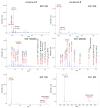Antimicrobial Diterpenes from Rough Goldenrod (Solidago rugosa Mill.)
- PMID: 37175200
- PMCID: PMC10180332
- DOI: 10.3390/molecules28093790
Antimicrobial Diterpenes from Rough Goldenrod (Solidago rugosa Mill.)
Abstract
Solidago rugosa is one of the goldenrod species native to North America but has sporadically naturalized as an alien plant in Europe. The investigation of the root and leaf ethanol extracts of the plant using a bioassay-guided process with an anti-Bacillus assay resulted in the isolation of two antimicrobial components. Structure elucidation was performed based on high-resolution tandem mass spectrometric and one- and two-dimensional NMR spectroscopic analyses that revealed (-)-hardwickiic acid (Compound 1) and (-)-abietic acid (Compound 2). The isolates were evaluated for their antimicrobial properties against several plant pathogenic bacterial and fungal strains. Both compounds demonstrated an antibacterial effect, especially against Gram-positive bacterial strains (Bacillus spizizenii, Clavibacter michiganensis subsp. michiganensis, and Curtobacterium flaccumfaciens pv. flaccumfaciens) with half maximal inhibitory concentration (IC50) between 1 and 5.1 µg/mL (5-20 times higher than that of the positive control gentamicin). In the used concentrations, minimal bactericidal concentration (MBC) was reached only against the non-pathogen B. spizizenii. Besides their activity against Fusarium avenaceum, the highest antifungal activity was observed for Compound 1 against Bipolaris sorokiniana with an IC50 of 3.8 µg/mL.
Keywords: (–)-abietic acid; (–)-hardwickiic acid; antibacterial effect; antifungal effect; bioassay-guided isolation; high-performance thin-layer chromatography–effect-directed analysis.
Conflict of interest statement
The authors declare no conflict of interest.
Figures



References
-
- Szymura M., Szymura T.H. Interactions between Alien Goldenrods (Solidago and Euthamia Species) and Comparison with Native Species in Central Europe. Flora Morphol. Distrib. Funct. Ecol. Plants. 2016;218:51–61. doi: 10.1016/j.flora.2015.11.009. - DOI
-
- Weber E. The Dynamics of Plant Invasions: A Case Study of Three Exotic Goldenrod Species (Solidago L.) in Europe. J. Biogeogr. 1998;25:147–154. doi: 10.1046/j.1365-2699.1998.251119.x. - DOI
-
- Euro+Med PlantBase. [(accessed on 12 April 2023)]. Available online: https://europlusmed.org.
-
- Solidago rugosa Mill. [(accessed on 12 April 2023)]. Available online: https://powo.science.kew.org/taxon/urn:lsid:ipni.org:names:249846-1.
-
- Känzig-Schoch U. Häufigkeit Und Verbreitung von Himantoglossum hircinum Im Kanton Bern. Bot. Helv. 2006;116:91–118. doi: 10.1007/s00035-006-0116-9. - DOI
MeSH terms
Substances
Grants and funding
LinkOut - more resources
Full Text Sources
Molecular Biology Databases

